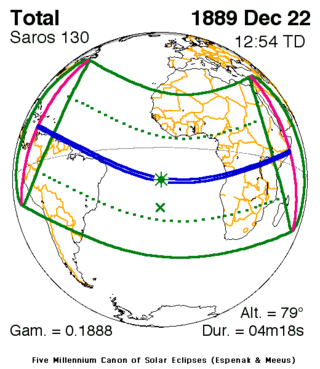| Solar eclipse of December 22, 1889 | |
|---|---|
| Type of eclipse | |
| Nature | Total |
| Gamma | 0.1888 |
| Magnitude | 1.0449 |
| Maximum eclipse | |
| Duration | 258 s (4 min 18 s) |
| Coordinates | 12°42′S 12°48′W / 12.7°S 12.8°W |
| Max. width of band | 152 km (94 mi) |
| Times (UTC) | |
| Greatest eclipse | 12:54:15 |
| References | |
| Saros | 130 (45 of 73) |
| Catalog # (SE5000) | 9257 |
A total solar eclipse occurred at the Moon's descending node of orbit on Sunday, December 22, 1889, with a magnitude of 1.0449. A solar eclipse occurs when the Moon passes between Earth and the Sun, thereby totally or partly obscuring the image of the Sun for a viewer on Earth. A total solar eclipse occurs when the Moon's apparent diameter is larger than the Sun's, blocking all direct sunlight, turning day into darkness. Totality occurs in a narrow path across Earth's surface, with the partial solar eclipse visible over a surrounding region thousands of kilometres wide. Occurring only about 12.5 hours before perigee (on December 23, 1889, at 1:30 UTC), the Moon's apparent diameter was larger.[1]
The path of totality was visible from parts of modern-day Trinidad and Tobago, northern French Guiana, Angola, the Democratic Republic of the Congo, Rwanda, Burundi, Tanzania, Kenya, and Somalia. A partial solar eclipse was also visible for parts of the eastern Caribbean, northern and central South America, and Africa.
The eclipse was the focus of a 242-day United States scientific expedition, roughly 70 miles south of Luanda.
- ^ "Moon Distances for London, United Kingdom, England". timeanddate. Retrieved 27 August 2024.
